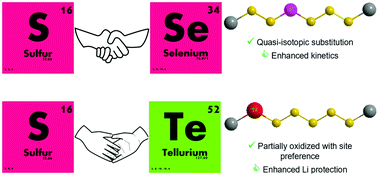Implications of in situ chalcogen substitutions in polysulfides for rechargeable batteries†
Abstract
The electrochemical behavior of sulfur-based batteries is intrinsically governed by polysulfide species. Here, we compare the substitutions of selenium and tellurium into polysulfide chains and demonstrate their beneficial impact on the chemistry of lithium–sulfur batteries. While selenium-substituted polysulfides enhance cathode utilization by effectively catalyzing the sulfur/Li2S conversion reactions due to the preferential formation of radical intermediates, tellurium-substituted polysulfides improve lithium cycling efficiency by reducing into a passivating interfacial layer on the lithium surface with low Li+-ion diffusion barriers. This unconventional strategy based on “molecular engineering” of polysulfides and exploiting the intrinsic polysulfide shuttle effect is validated by a ten-fold improvement in the cycle life of lean-electrolyte “anode-free” pouch cells. Assembled with no free lithium metal at the anode, the anode-free configuration maximizes the energy density, mitigates the challenges of handling thin lithium foils, and eliminates self-discharge upon cell assembly. The insights generated into the differences between selenium and tellurium chemistries can be applied to benefit a broad range of metal–chalcogen batteries as well as chalcogenide solid electrolytes.



 Please wait while we load your content...
Please wait while we load your content...